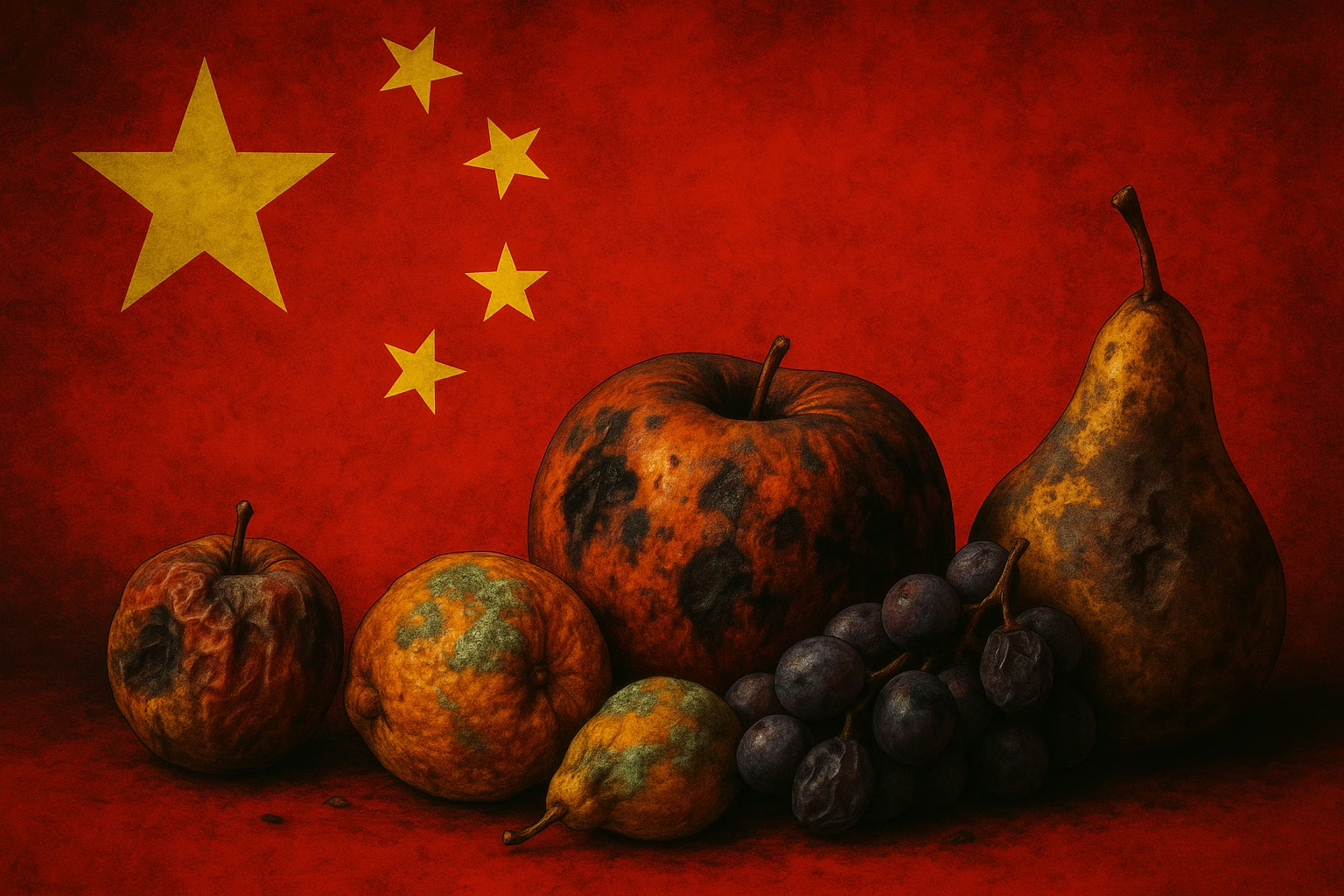Customers seize affordable Chilean cherries at a Tianjin supermarket amid China’s Lunar New Year rush. Once a luxury, cherries now epitomize the nation’s consumption slump.
China’s relationship with fruit goes far beyond mere nutrition – it’s woven into folklore, festivals, and fortunes. From mandarin oranges symbolizing prosperity to peaches promising longevity, fruits have long been auspicious tokens in Chinese culture. Gift baskets brimming with glossy apples (for peace) and golden oranges (for luck) are staples of Lunar New Year traditions. Even at ancestral tombs and temple altars, offerings of fruit express respect and hope for blessings. In short, fruit in China isn’t just food – it’s a cultural currency, sweetened with symbolism and superstition.
But lately, that cultural currency is losing its flavor. Despite the historic reverence for abundant harvests, modern China’s fruit market is showing signs of rot – literally and figuratively. A combination of economic slowdown, changing consumer habits, and safety scares has left piles of unsold produce decaying in orchards and warehouses. Shiny apples and plump grapes that once conveyed abundance are now telling a more ominous story about China’s economy.

From Orchard to Anomaly: China’s Fruits Losing Favor
Not long ago, China was celebrating record fruit harvests, boasting the world’s largest output. In 2021, Chinese orchards yielded nearly 300 million tons of fruit, flooding markets with everything from apples to dragon fruit. Yet high yield has not meant high demand – an astonishing 12 million tons of Chinese-grown fruit go to waste each year. Despite overflowing supply, domestic fruits often struggle to find buyers, ending up as pig feed or rotting garbage. What’s going on in the Fruit Kingdom?
Part of the problem is quality. Chinese consumers have grown wary of local produce after a series of food safety scandals. Reports of excessive pesticides, preservatives, and artificial additives have rocked trust in the fruit industry. In one alarming exposé, farmers revealed they sprayed grapes 24 times with pesticides per growing season – one blogger quipped that each grape could be its own periodic table. Sunshine Rose grapes, celebrated for their giant size, turned into a public relations nightmare when Thai authorities found 23 out of 24 samples laced with illegal levels of residues. From wax-coated oranges to growth-hormone strawberries, tales of “Franken-fruits” have proliferated on social media, eroding consumers’ appetites. Shoppers joked darkly that fruits now seem “immortal” – grapes and kumquats that never rot thanks to chemical baths. In a country where freshness once equaled fortune, produce that won’t decay is more creepy than comforting.
Safety fears alone might not tank a whole market, but they arrived atop an economic chill that has Chinese wallets snapping shut. Consumer confidence has been bruised, and fruit – often seen as a discretionary good or gift – is an early casualty of frugal budgets. There’s even a buzzword for it: “消费降级” or “consumption downgrade.” As incomes shrink and job prospects dim, people cut back on little luxuries, from Starbucks lattes to imported cherries. Indeed, cherries became a symbol of middle-class belt-tightening during China’s recent slowdown. For years, the phrase “Cherry Freedom” trended online – the idea that being able to splurge on cherries was a sign you’d made it. But by early 2025, cherry freedom took on a new twist: a bumper crop from Chile sent cherry prices plunging over 70%, suddenly within reach of ordinary shoppers. Throngs rushed to grab 30-yuan half-kilos of cherries, giddy at the great deal. “I can eat cherries without feeling guilty again!” cheered one netizen, as the once-pricey fruit fell off its pedestal. The irony? It wasn’t newfound prosperity granting this “freedom” – it was oversupply and weakened demand. Cheap cherries are sweet to consumers, but they’ve left farmers with sour faces.
The Fruits of Slowdown: By the Numbers
China’s fruit fatigue isn’t just anecdotal – the data shows a clear softening of appetite. After over a decade of steady growth, fruit consumption in China actually declined in 2024. Total fruit volume consumed dipped by about 1%, to 265 million tons, marking a rare reversal for a country that had been steadily munching more produce each year In value terms the market sagged even further: fruit sales by revenue dropped over 5% in 2024, reflecting consumers trading down or buying less. That pullback aligns with broader economic strains – with China’s GDP growth slowing and youth unemployment surging, shoppers are cautious. Expensive fruits and gift boxes are among the first things to go when belts are tightened.
On the supply side, gluts and price crashes have become common. In early 2025, apple and mango growers reportedly dumped truckloads of unsold fruit as prices fell below break-even. One viral video showed a fruit vendor in tears, smashing crates of unsold oranges in frustratio. “Not a single yuan spent by customers today!” he shouted, standing shirtless in despair amidst piles of rotting fruit. Such scenes underscore a cruel paradox: abundant harvests coinciding with weak demand. High supply + low consumption = low prices – good for bargain-hunters, devastating for farmers. In some regions, wholesale fruit prices fell so low in 2024 that they didn’t even cover fertilizer costs. Farmers who once saw orchards as a ticket out of poverty are now watching their profits wither on the vine.
The imported fruit invasion is another twist. Chinese-grown fruits have oddly become second-class in their own market, as middle-class consumers favor imports perceived as safer or higher quality. “China doesn’t lack fruit, it lacks good fruit,” one local outlet quipped. Shiny Thai durians, Chilean cherries, and Ecuadorian bananas fetch premium prices, while local produce languishes. This preference gap has meant domestic fruits often can’t compete, intensifying the surplus. The status symbol of an imported pomelo or dragonfruit from afar leaves local farmers in a bind: quantity without market. In 2024, China’s fruit imports actually rose slightly even as overall consumption fell, signaling that consumers who did buy fruit often opted for foreign varieties. Meanwhile, China’s fruit exports jumped by over 20% in volume – a sign that producers are desperately pushing excess fruit overseas to find takers.
Rotten China’s Fruits, Riper Problems
What does this fruit foray mean for China’s bigger picture? For one, it’s a red flag on consumer spending. Beijing has been urging a shift to a consumption-driven economy, relying less on infrastructure and exports. But weak fruit sales suggest Chinese consumers remain in belt-tightening mode, prioritizing essentials and saving cash for the uncertain times ahead. If people hesitate to spend on something as simple as fruit, it bodes ill for cars, appliances, or homes. Fruit is a leading indicator of the economic mood – and right now, that mood is cautious, even grim. President Xi Jinping’s government has noticed; they’ve rolled out campaigns urging citizens to spend and even eat more (sometimes framing it as patriotic duty). But frugality born of economic anxiety isn’t easily reversed by propaganda.
There are public health angles too. If fruit consumption stays low, nutritional deficits could worsen. Traditionally, Chinese diets were rich in vegetables but lighter on fruits (especially in poorer areas), and doctors have long pushed the public to eat more produce for health. A sustained drop could increase long-term risks of diet-related issues. Conversely, the safety scare around fruits shows consumers exercising caution – they are effectively boycotting produce they don’t trust. This could pressure regulators to finally crack down on the pesticide abuse and food fraud that spark. In that sense, empty fruit stalls might ultimately force much-needed reforms in agricultural practices and food safety enforcement.
Economically, the fruit fiasco is hurting China’s vast rural population. Farmers already struggling with rising costs and slim margins now face wasted harvests and sinking incomes. Rural household wealth is taking a hit, which in turn reduces their spending on other goods – a vicious cycle for domestic consumption. Social stability could be tested if rural discontent grows; Beijing, acutely aware of history, does not want angry farmers (the seeds of past unrest in China often sprouted in the countryside). The government has responded by purchasing some excess fruit for state reserves and food banks, and by touting e-commerce “farm-to-table” programs to help farmers sell online. Still, those are band-aids on a deeper wound of overproduction meeting under-demand.
Globally, China’s fruit funk has ripple effects. Neighboring Asian countries that export produce to China are feeling the pinch. For example, Vietnam saw its fruit and vegetable exports to China plunge by nearly 39% in early 2025 as China tightened quality checks and demand slackened. Suppliers from Thailand to Peru who banked on China’s voracious market are scrambling as orders dry up. On the flip side, Chinese consumers shifting to cheaper domestic fruit (or buying less overall) means some imported fruit has piled up too – benefiting consumers elsewhere with lower prices. The Chilean cherry glut is a case in point: record exports to China depressed prices so much that cherries became affordable to Chinese families , likely diverting some Chilean fruit that would have gone to other markets. Commodity trade flows are adjusting to China’s new normal of softer demand.
India and the Global Fruit Basket: A SWOT Perspective
China’s souring fruit market offers a mix of cautionary tales and opportunities for other nations, including India. Here’s a quick SWOT analysis from an Indian and global standpoint:
- Strengths (for others): China’s pullback could open doors for rival exporters. If Chinese consumers lose trust in domestic fruit, countries with reputations for quality (Australia’s citrus, India’s Alphonso mangoes, etc.) might fill niche demand. Moreover, a China that’s less of a commodity hog can mean lower global fruit prices – helpful for importers and consumers worldwide.
- Weaknesses: A faltering Chinese market can drag down global growth. Farmers in countries dependent on China (like dragonfruit growers in Vietnam or cherry orchards in Chile) are taking losses. India, while not as tied into China for fruit trade, could indirectly feel price volatility in regional markets.
- Opportunities: India can learn from China’s mistakes. Emphasizing food safety, enforcing pesticide regulations, and building robust supply chains can help Indian producers avoid a crisis of confidence. There’s also a chance for India’s exporters to target Chinese consumers by highlighting higher quality or organic produce – effectively turning China’s “lack of good fruits” into a selling point for Indian farmers. Additionally, India’s own fruit consumption per capita is relatively low; ensuring rising incomes translate to healthier diets could capture domestic economic gains that China is currently missing.
- Threats: If China’s economic woes deepen (with fruit as a symptom), the global economy may face headwinds. A China in slowdown buys less of everything – from apples to iPhones – which can stifle demand across markets. For India, a significant China slump might mean cheaper imports (good for inflation) but also fiercer competition in export sectors and potentially less foreign investment all around, if global investors get skittish about emerging markets.
Ultimately, the tale of China’s rotting fruit is both literal and metaphorical. Literally, it’s about apples and peaches left unsold, about farmers in Shandong or Guangxi despairing as tons of produce turn to mush. Metaphorically, it’s about the low-hanging fruit of China’s economic boom being gone – and the harder climb that lies ahead. As China grapples with this transition, the world (and India) watches closely, hoping that the world’s second-largest economy doesn’t let one bad apple spoil the whole barrel. In the meantime, perhaps it’s fitting that in Chinese, the word for crisis (危机) contains the character for opportunity. If China can clean up its fruit industry and rekindle consumers’ trust and spending, it might yet turn this sour harvest into a sweeter tomorrow. For now, though, the fruit on China’s economic tree is looking a tad overripe – and everyone from farmers in Fujian to grocers in New Delhi can smell it. China will need to get its economic orchard in order, or risk an even larger basket of troubles.
📌 Also Read
🗞️ Khalistan Movement in Canada: Why India Must Call Out Canada Now
A sharp dive into Canada’s double standards and the growing threat of separatist politics nurtured overseas. While China’s economy may be rotting from within, Canada seems busy cultivating chaos from without.












